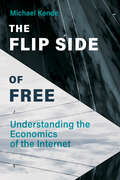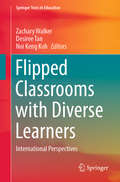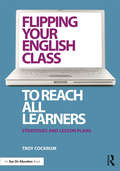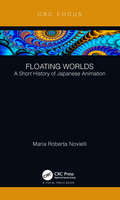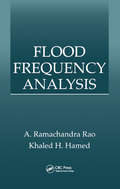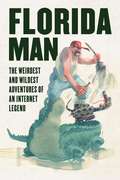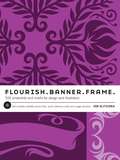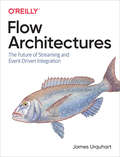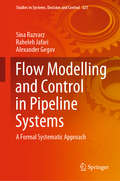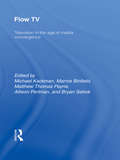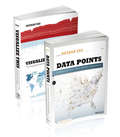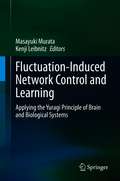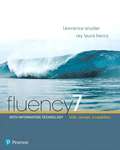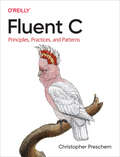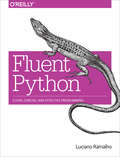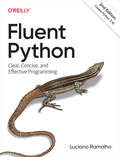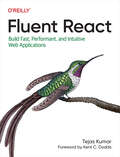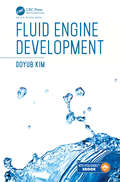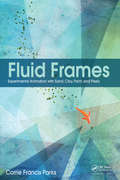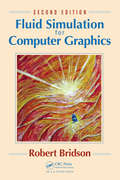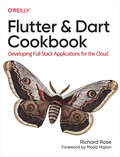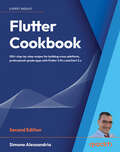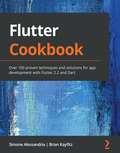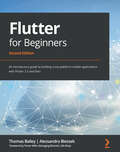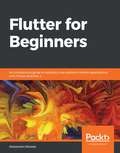- Table View
- List View
The Flip Side of Free: Understanding the Economics of the Internet
by Michael KendeWhy "free" comes at a price: the costs of free internet services in terms of privacy, cybersecurity, and the growing market power of technology giants.The upside of the internet is free Wi-Fi at Starbucks, Facetime over long distances, and nearly unlimited data for downloading or streaming. The downside is that our data goes to companies that use it to make money, our financial information is exposed to hackers, and the market power of technology companies continues to increase. In The Flip Side of Free, Michael Kende shows that free internet comes at a price. We're beginning to realize this. Our all-purpose techno-caveat is "I love my smart speaker...but"--is it really tracking everything I do? listening to everything I say?
Flipped Classrooms with Diverse Learners: International Perspectives (Springer Texts in Education)
by Noi Keng Koh Zachary Walker Desiree TanThis book addresses the background of classroom flipping, explores the theoretical underpinnings for why flipping works, and shares current success stories in practice. It provides diverse international examples of classroom flipping for all ages, includes discussions of the authors’ studies in the context of the existing research, and illustrates the impact that classroom flipping has had across a range of educational settings instead of focusing on a specific domain or learner context. Intended as a handbook for practitioners, the analysis of commonly used, highly effective techniques for learners of various ages fills a major gap in the literature. It offers a valuable resource for educators, helping them make the flipped learning experience an impactful and meaningful one.
Flipping Your English Class to Reach All Learners: Strategies and Lesson Plans
by Troy CockrumLearn how flipping your English language arts classroom can help you reach students of different abilities, improve classroom management, and give you more time to interact with each student. This practical book shows why flipped classrooms are effective and how they work. You will find out how to flip your instruction in writing, reading, language, and speaking and listening while meeting the Common Core State Standards. A variety of step-by-step lesson plans are provided.
Floating Worlds: A Short History of Japanese Animation (Focus Animation Ser.)
by Maria Roberta NovielliThrough the analysis of the work of the main Japanese animators starting from the pioneers of 1917, the book will overview the whole history of Japanese animated film, including the latest tendencies and the experimental movies. In addition to some of the most acclaimed directors Miyazaki Hayao, Takahata Isao, Shinkai Makoto, Tezuka Osamu and Kon Satoshi, the works of masters of animation such as Kawamoto Kihachirō, Kuri Yōji, Ōfuji Noburō and Yamamura Kōji will be analysed in their cultural and historical context. Moreover, their themes and styles will be the linking thread to overview the Japanese producing system and the social and political events which have often influenced their works. Key Features Insight into both mainstream and independent cinema Scientific reliability Easy readability Social and cultural context
Flood Frequency Analysis
by A. Ramachandra Rao Khaled H. HamedAfter five decades, the field of Statistical Hydrology continues to evolve and remains a very active area of investigation. Researchers continue to examine various distributions, methods of estimation of parameters, and problems related to regionalization. However, much of this research appears in journals and reports and usually in a form not easi
Florida Man: The Weirdest and Wildest Adventures of an Internet Legend
by Skyhorse PublishingA full year's worth of the strangest, most outlandish antics of one of the Internet's true titans: Florida Man! Plus, for the first time ever . . . the equally bizarre, equally outrageous Florida Woman! Go to Google and type in your birth date and the words "Florida Man." Weird, right? Well, you haven't seen anything yet! That's just one day in the life of a Florida Man. Originally a beloved Internet game made possible by Florida's Sunshine Laws, "Florida Man" has now become a phrase unto itself, a shorthand expression used online to capture the antics of Florida's residents, who somehow seem to find themselves in bizarre situations regularly. Now, Florida Man is here to collect the 366 greatest, most unusual adventures of both Florida Man and Florida Woman, sorted day-by-day from January 1 through December 31st. (Plus, special leap-year headlines for those readers who just can't get enough mayhem during the regular year!)Florida Man features headlines such as: "Florida Man Throws Alligator Into Wendy&’s Drive-Thru Window"&“Florida Man Shoots Self, Realizes it Three Days Later&”"How Trump Became a Florida Man"plus, corresponding Florida Woman headlines like "Florida woman attacked by &‘aggressive&’ otter says 'severe bites' left her temporarily unable to walk&” This collection of classic Florida weirdness will astound and amuse even the most jaded, world-weary reader. Just don't go trying any of Florida Man's—or Florida Woman's—ideas for yourself!
Flourish. Banner. Frame.: 615 Ornaments and Motifs for Design and Illustration
by Glitschka VonOrnaments and motifs add something special to creative projects, but not all creatives can devote the hundreds of hours necessary to developing them. Flourish. Banner. Frame. is an amazing library of 555 original symbols, floral motifs, border treatments, frills, banners, shields, crests, ornaments, decorative frames, placards and cartouches. Each design element has been crafted with vector precision, and you can use this artwork within the context of your own projects, whether they are personal or professional in nature.There are 10 real-life examples in the book, so you can be inspired by top designers and illustrators. This extensive volume of ornaments and motifs is easy to use for any design or illustration project: publication layouts, book covers, website backgrounds, t-shirt graphics, scrapbooks, textiles, crafts, stencils, tattoos-and everything in between. Whether you are a beginner or an advanced design professional, you’ll turn to this resource again and again for years to come.Royalty-free ornaments included on DVD for your use!
Flow Architectures: The Future Of Streaming And Event-driven Integration
by James UrquhartSoftware development today is embracing events and streaming data, which optimizes not only how technology interacts but also how businesses integrate with one another to meet customer needs. This phenomenon, called flow, consists of patterns and standards that determine which activity and related data is communicated between parties over the internet.This book explores critical implications of that evolution: What happens when events and data streams help you discover new activity sources to enhance existing businesses or drive new markets? What technologies and architectural patterns can position your company for opportunities enabled by flow? James Urquhart, global field CTO at VMware, guides enterprise architects, software developers, and product managers through the process.Learn the benefits of flow dynamics when businesses, governments, and other institutions integrate via events and data streamsUnderstand the value chain for flow integration through Wardley mapping visualization and promise theory modelingWalk through basic concepts behind today's event-driven systems marketplaceLearn how today's integration patterns will influence the real-time events flow in the futureExplore why companies should architect and build software today to take advantage of flow in coming years
Flow Modelling and Control in Pipeline Systems: A Formal Systematic Approach (Studies in Systems, Decision and Control #321)
by Sina Razvarz Raheleh Jafari Alexander GegovThis book introduces novel methods for leak and blockage detection in pipelines. The leak happens as a result of ageing pipelines or extreme pressure forced by operational error or valve rapid variation. Many factors influence blockage formation in pipes like wax deposition that leads to the formation and eventual growth of solid layers and deposition of suspended solid particles in the fluids. In this book, initially, different categories of leak detection are overviewed. Afterwards, the observability and controllability of pipeline systems are analysed. Control variables can be usually presented by pressure and flow rates at the start and end points of the pipe. Different cases are considered based on the selection of control variables to model the system. Several theorems are presented to test the observability and controllability of the system. In this book, the leakage flow in the pipelines is studied numerically to find the relationship between leakage flow and pressure difference. Removing leakage completely is almost impossible; hence, the development of a formal systematic leakage control policy is the most reliable approach to reducing leakage rates.
Flow TV: Television in the Age of Media Convergence
by Michael KackmanFrom viral videos on YouTube to mobile television on smartphones and beyond, TV has overflowed its boundaries. If Raymond Williams' concept of flow challenges the idea of a discrete television text, then convergence destabilizes the notion of television as a discrete object. Flow TV examines television in an age of technological, economic, and cultural convergence. Seeking to frame a new set of concerns for television studies in the 21st century, this collection of all new essays establishes television’s continued importance in a shifting media culture. Considering television and new media not as solely technical devices, but also as social technologies, the essays in this anthology insist that we turn our attention to the social, political, and cultural practices that surround and inform those devices' use. The contributors examine television through a range of critical approaches from formal and industrial analysis to critical technology studies, reception studies, political economy, and critiques of television's transnational flows. This volume grows out of the critical community formed around the popular online journal Flow: A Critical Form on Television and Media Culture (flowtv.org). It is ideal for courses in television studies or media convergence.
FlowingData.com Data Visualization Set
by Nathan YauVisualize This is a guide on how to visualize and tell stories with data, providing practical design tips complemented with step-by-step tutorials. It begins with a description of the huge growth of data and visualization in industry, news, and gov't and opportunities for those who tell stories with data. Logically it moves on to actual stories in data-statistical ones with trends and human stories. the technical part comes up quickly with how to gather, parse and format data with Python, R, Excel, Google docs, etc and details tools to visualize data-native graphics for the Web like ActionScript, Flash libraries, PHP, JavaScript, CSS, HTML. Every chapter provides an example as well. Patterns over time and kinds of data charts are followed by proportions, chart types and examples. Next, examples and descriptions of outliers and how to show them, different kinds of maps, how to guide your readers and explain the data "in the visualization". The book ends with a value-add appendix on graphical perception.Data Points focuses on the approach to visualization and data. Visualization is a medium that can be used as a tool, art, a way to tell stories, etc., Data Points guides readers through making data approachable through visualization techniques and best practices. The focus is on designing with a purpose in mind. Data Points discusses why recipes (from the rules) work and expands on how readers can make their own recipes. The book is example-driven, featuring work from people in areas of art, design, business, statistics, computer science, cartography, and online media, as well as many of the author's own illustrations. The major sections of the book cover:Visualization as Medium -- In the same way not all movies are documentaries, not all visualization is about optimal visual perception. Data Representation -- There are rules across all visualization applications, such as the use of appropriate shapes to accurately represent values.Design with Purpose -- Rules can be broken though. It all depends on who and what you're designing for.Data Points digs deep into the foundations of data visualization:Understanding Data and VisualizationRepresenting DataExploring Data VisuallyDesigning for an AudienceVisualizing with ClarityPutting Everything Into Practice with Tools and Resources
Fluctuation-Induced Network Control and Learning: Applying the Yuragi Principle of Brain and Biological Systems
by Masayuki Murata Kenji LeibnitzFrom theory to application, this book presents research on biologically and brain-inspired networking and machine learning based on Yuragi, which is the Japanese term describing the noise or fluctuations that are inherently used to control the dynamics of a system. The Yuragi mechanism can be found in various biological contexts, such as in gene expression dynamics, molecular motors in muscles, or the visual recognition process in the brain. Unlike conventional network protocols that are usually designed to operate under controlled conditions with a predefined set of rules, the probabilistic behavior of Yuragi-based control permits the system to adapt to unknown situations in a distributed and self-organized manner leading to a higher scalability and robustness.The book consists of two parts. Part 1 provides in four chapters an introduction to the biological background of the Yuragi concept as well as how these are applied to networking problems. Part 2 provides additional contributions that extend the original Yuragi concept to a Bayesian attractor model from human perceptual decision making. In the six chapters of the second part, applications to various fields in information network control and artificial intelligence are presented, ranging from virtual network reconfigurations, a software-defined Internet of Things, and low-power wide-area networks.This book will benefit those working in the fields of information networks, distributed systems, and machine learning who seek new design mechanisms for controlling large-scale dynamically changing systems.
Fluency with Information Technology: Skills, Concepts, and Capabilities
by Lawrence Snyder Ray Henry<p>Having grown up with computers, most readers already know how to use Information Technology (IT) in their daily lives--but use is not understanding. More than ever, they must become "computational thinkers," able to conceptualize where and how computation can be used effectively. <p>Equipping readers with a deeper understanding of the broad capabilities of technology, Fluency with Information Technology, 7th Edition uses a project-oriented learning approach supported by examples and realistic problem-solving scenarios. Authors Larry Snyder and Ray Henry teach readers to navigate IT independently and become effective users of today's resources, forming a foundation of skills they can adapt to their personal and career goals as future technologies emerge. The text's approach is centered on three types of content--skills, concepts, and capabilities--that prepare readers to adapt to an ever-changing computing environment. This 7th Edition incorporates updates and new content that mirrors the way contemporary readers encounter technology in their lives.</p>
Fluent C
by Christopher PreschernExpert advice on C programming is hard to find. While much help is available for object-oriented programming languages, there's surprisingly little for the C language. With this hands-on guide, beginners and experienced C programmers alike will find guidance about design decisions, including how to apply them bit by bit to running code examples when building large-scale programs.Christopher Preschern, a leading member of the design patterns community, answers questions such as how to structure C programs, cope with error handling, or design flexible interfaces. Whether you're looking for one particular pattern or an overview of design options for a specific topic, this book shows you how to implement hands-on design knowledge specifically for the C programming language.You'll find design patterns for:Error handlingReturning error informationMemory managementReturning data from C functionsData lifetime and ownershipFlexible APIsFlexible iterator interfacesOrganizing files in modular programsEscaping #ifdef Hell
Fluent Python
by Luciano RamalhoPython's simplicity lets you become productive quickly, but this often means you aren't using everything it has to offer. With this hands-on guide, you'll learn how to write effective, idiomatic Python code by leveraging its best--and possibly most neglected--features. Author Luciano Ramalho takes you through Python's core language features and libraries, and shows you how to make your code shorter, faster, and more readable at the same time.Many experienced programmers try to bend Python to fit patterns they learned from other languages, and never discover Python features outside of their experience. With this book, those Python programmers will thoroughly learn how to become proficient in Python 3.This book covers:Python data model: understand how special methods are the key to the consistent behavior of objectsData structures: take full advantage of built-in types, and understand the text vs bytes duality in the Unicode ageFunctions as objects: view Python functions as first-class objects, and understand how this affects popular design patternsObject-oriented idioms: build classes by learning about references, mutability, interfaces, operator overloading, and multiple inheritanceControl flow: leverage context managers, generators, coroutines, and concurrency with the concurrent.futures and asyncio packagesMetaprogramming: understand how properties, attribute descriptors, class decorators, and metaclasses work
Fluent Python: Clear, Concise, And Effective Programming
by Luciano RamalhoDon't waste time bending Python to fit patterns you've learned in other languages. Python's simplicity lets you become productive quickly, but often this means you aren't using everything the language has to offer. With the updated edition of this hands-on guide, you'll learn how to write effective, modern Python 3 code by leveraging its best ideas.Discover and apply idiomatic Python 3 features beyond your past experience. Author Luciano Ramalho guides you through Python's core language features and libraries and teaches you how to make your code shorter, faster, and more readable.Complete with major updates throughout, this new edition features five parts that work as five short books within the book:Data structures: Sequences, dicts, sets, Unicode, and data classesFunctions as objects: First-class functions, related design patterns, and type hints in function declarationsObject-oriented idioms: Composition, inheritance, mixins, interfaces, operator overloading, protocols, and more static typesControl flow: Context managers, generators, coroutines, async/await, and thread/process poolsMetaprogramming: Properties, attribute descriptors, class decorators, and new class metaprogramming hooks that replace or simplify metaclasses
Fluent React
by Tejas KumarWhen it comes to building user interfaces on the web, React enables web developers to unlock a new world of possibilities. This practical book helps you take a deep dive into fundamental concepts of this JavaScript library, including JSX syntax and advanced patterns, the virtual DOM, React reconciliation, and advanced optimization techniques. By becoming fluent in React, you'll quickly learn how to build better web applications.Author Tejas Kumar helps you explore the depths of React in plain English, without the typical software engineering jargon, so you can more easily understand how this JavaScript library works. You'll learn how to write intuitive React code that fully understands the nuances and layers of React, unlocking a whole new level of fluency.You will:Understand how React works at a deeper levelWrite React apps while optimizing them along the wayBuild resilient React applications that work well at arbitrary scaleCreate React applications for other platforms adjacent to the web and mobile devicesKnow when to reach for different mechanisms exposed by React, such as reducers versus state versus refs
Fluid Engine Development
by Doyub KimFrom the splash of breaking waves to turbulent swirling smoke, the mathematical dynamics of fluids are varied and continue to be one of the most challenging aspects in animation. Fluid Engine Development demonstrates how to create a working fluid engine through the use of particles and grids, and even a combination of the two. Core algorithms are explained from a developer’s perspective in a practical, approachable way that will not overwhelm readers. The Code Repository offers further opportunity for growth and discussion with continuously changing content and source codes. This book helps to serve as the ultimate guide to navigating complex fluid animation and development. Explains how to create a fluid simulation engine from scratch Offers an approach that is code-oriented rather than math-oriented, allowing readers to learn how fluid dynamics works with code, with downloadable code available Explores various kinds of simulation techniques for fluids using particles and grids Discusses practical issues such as data structure design and optimizations Covers core numerical tools including linear system and level set solvers
Fluid Frames: Experimental Animation with Sand, Clay, Paint, and Pixels
by Corrie Francis ParksOnce the realm of a few stalwart artists, animating with sand, clay, and wet paint is now accessible for all filmmakers with an experimental frame of mind. Created directly under the camera with frame-by-frame stopmotion, this "fluid frame animation" provides a completely unique visual world for animators. While pioneering animators such as Caroline Leaf, Alexander Petrov, and Ishu Patel paved the way, the availability of frame capture programs, compositing software and digital workflow is opening up new avenues of exploration for artists of all experience levels. This book will walk you through setting up your studio, choosing and working with your materials, and combining the physical under-the-camera production with digital compositing and effects to enhance your animation.· Firsthand advice from experimental animation veterans and rising stars in the field· Covers the digital aspects of experimental animation, including the latest techniques in After Effects CC· Tutorials and source files for under-the-camera approaches and After Effects enhancements on the book’s companion website In addition to the practical advice, you’ll find historical and contemporary examples of successful films, step-by-step tutorials for working under the camera and working with the footage digitally, and interviews and tips from artists who are currently pushing the boundaries in these experimental mediums. Stacked with information and images from over 30 artists, this book is an indispensable resource for both the student and professional wishing to get their hands dirty in an increasingly digital world.
Fluid Simulation for Computer Graphics
by Robert BridsonA practical introduction, the second edition of Fluid Simulation for Computer Graphics shows you how to animate fully three-dimensional incompressible flow. It covers all the aspects of fluid simulation, from the mathematics and algorithms to implementation, while making revisions and updates to reflect changes in the field since the first edition. Highlights of the Second Edition New chapters on level sets and vortex methods Emphasizes hybrid particle–voxel methods, now the industry standard approach Covers the latest algorithms and techniques, including: fluid surface reconstruction from particles; accurate, viscous free surfaces for buckling, coiling, and rotating liquids; and enhanced turbulence for smoke animation Adds new discussions on meshing, particles, and vortex methods The book changes the order of topics as they appeared in the first edition to make more sense when reading the first time through. It also contains several updates by distilling author Robert Bridson’s experience in the visual effects industry to highlight the most important points in fluid simulation. It gives you an understanding of how the components of fluid simulation work as well as the tools for creating your own animations.
Flutter and Dart Cookbook
by Rich RoseLearn the essentials of working with Flutter and Dart to build full stack applications that meet the needs of a cloud-driven world. Together, the Flutter open source UI software development kit and the Dart programming language for client development provide a unified solution to building applications capable of targeting multiple platforms. Recipes in this cookbook show you how this potent combination provides an efficient approach to application development.Typically used in frontend development, Flutter helps you develop cross-platform applications for Android, iOS, Linux, Mac, Windows, and the Google Fuchsia operating systems. The Dart SDK provides native access to third-party solutions, including APIs, databases, and authentication. When used in concert with Flutter, Dart allows you to compile source code ahead of time to native code.This cookbook shows you how to:Write effective Dart code by using variables and data structuresBuild applications with Flutter by exploring widgets and data handlingUnderstand cloud provider solutions and learn how to integrate them with FlutterManage data through APIs using Google Cloud ServerlessWork with Firebase solutions such as Authentication and the Cloud Firestore databaseBuild web applications that also work with mobile and desktop platforms
Flutter Cookbook: 100+ step-by-step recipes for building cross-platform, professional-grade apps with Flutter 3.10.x and Dart 3.x, 2nd Edition
by Simone AlessandriaWrite, test and publish your web, desktop, and embedded apps with this most up-to-date book on Flutter using the Dart programming language.Key FeaturesThoroughly updated to cover the latest features in Flutter 3.10.x and Dart 3.xPractical recipes to publish responsive, multi-platform apps from a single databaseCovers not just the how's' but the why's' of Flutter's features with examplesBook DescriptionAre you ready to tap into the immense potential of Flutter?With over 1,000 new mobile apps published every day on the Apple and Google Play stores, Flutter is transforming the landscape of app development. It's time for you to join the revolution.Introducing the second edition of Flutter Cookbook, a step-by-step guide designed exclusively for you. Whether you're a seasoned developer or just starting your coding journey, this book is your ultimate companion. Dive into the latest features of Flutter 3.10 and unlock the secrets to building professional-grade, cross-platform applications.With our recipe-based approach, we'll not only show you how to implement Flutter's features but also explain why they work. Through practical examples and real-world execution, you'll gain a deeper understanding of Flutter's inner workings. From crafting stunning UI/UX with widgets to leveraging hot reload and restart techniques, we'll equip you with best practices and invaluable knowledge.As you progress, you'll learn to efficiently manage data, add interactivity and animations, and integrate essential Flutter plugins like maps, camera, voice recognition and more. And let's not forget the dedicated chapter on implementing MLkit powered by TensorFlow Lite. We'll guide you through building custom machine learning solutions, expanding the capabilities of your apps.By the time you reach the end of this comprehensive Flutter book, you'll have the skills and confidence to write and deliver fully functional apps.What you will learnFamiliarize yourself with Dart fundamentals and set up your development environmentEfficiently track and eliminate code errors with proper toolsCreate various screens using multiple widgets to effectively manage dataCraft interactive and responsive apps by incorporating routing, page navigation, and input field text readingDesign and implement a reusable architecture suitable for any appMaintain control of your codebase through automated testing and developer toolingDevelop engaging animations using the necessary toolsEnhance your apps with ML features using Firebase MLKit and TensorFlow LiteSuccessfully publish your app on the Google Play Store and the Apple App StoreWho this book is forDevelopers who are familiar with the OOP language and prefer learning-by-doing will get the most out of this book.If you have some experience building apps on Flutter or have been playing around with the framework for some time now and have set eyes on developing mobile apps using Dart, then this book is for you.
Flutter Cookbook: Over 100 proven techniques and solutions for app development with Flutter 2.2 and Dart
by Simone Alessandria Brian KayfitzDiscover how to build, scale, and debug native iOS and Android applications from a single codebase using the Dart programming languageKey FeaturesQuickly build and iterate on your user interface (UI) with hot reloadFix bugs and prevent them from reappearing using Flutter's developer tools and test suitesDiscover practical recipes for building mobile applications with FlutterBook DescriptionFlutter is an open-source framework for building mobile, web, and desktop apps using the Dart language. With this recipe-based guide, which focuses on robust app design and core principles, you'll learn how to solve cross-platform development issues in a practical way. The Flutter Cookbook covers error handling and debugging to ensure that your apps run more efficiently. You'll start by setting up Flutter and customizing your development environment. The book will explain the main tasks involved in app development, such as user interface and user experience (UI/UX) design, API design, and creating animations. Later chapters get you up to speed with routing, retrieving data from web services, and persisting data locally. A dedicated section also focuses on Firebase and its machine learning capabilities. The last chapter is specifically designed to help you create apps for the web and desktop (Windows, Mac, and Linux). Throughout the book, you'll find recipes that cover the most important features needed to build a cross-platform application, along with insights into running a single codebase on different platforms. By the end of this Flutter book, you'll have learned everything you need to be able to write and deliver fully functional apps.What you will learnUse Dart programming to customize your Flutter applicationsDiscover how to develop and think like a Dart programmerLeverage Firebase Machine Learning capabilities to create intelligent appsCreate reusable architecture that can be applied to any type of appUse web services and persist data locallyDebug and solve problems before users can see themUse asynchronous programming with Future and StreamManage the app state with Streams and the BLoC pattern Who this book is forThis app development book is for beginner to intermediate-level developers who want to become mobile developers. Basic knowledge of modern programming languages such as JavaScript, Swift, Kotlin, Java, Objective-C, or C# will help you to understand the concepts covered in the book more easily.
Flutter for Beginners: An introductory guide to building cross-platform mobile applications with Flutter 2.5 and Dart, 2nd Edition
by Thomas Bailey Alessandro Biessek Trevor WillsDevelop the real-world experience you need to build and launch your own Flutter apps with this full-color guideKey FeaturesGet up to speed with the basics of Dart programming and delve into Flutter developmentLearn about Flutter widgets, plugins, and animations to create a high-quality app user experiencePackage and deploy your Flutter apps to achieve native-like performanceBook DescriptionThere have been many attempts at creating frameworks that are truly cross-platform, but most struggle to create a native-like experience at high performance levels. Flutter achieves this with an elegant design and a wealth of third-party plugins, making it the future of mobile app development. If you are a mobile developer who wants to create rich and expressive native apps with the latest Google Flutter framework, this book is for you.This book will guide you through developing your first app from scratch all the way to production release. Starting with the setup of your development environment, you'll learn about your app's UI design and responding to user input via Flutter widgets, manage app navigation and screen transitions, and create widget animations. You'll then explore the rich set of third party-plugins, including Firebase and Google Maps, and get to grips with testing and debugging. Finally, you'll get up to speed with releasing your app to mobile stores and the web.By the end of this Flutter book, you'll have gained the confidence to create, edit, test, and release a full Flutter app on your own.What you will learnExplore the core concepts of the Flutter framework and how it is used for cross-platform developmentUnderstand the fundamentals of the Dart programming languageWork with Flutter widgets and learn the concepts of stateful and stateless widgetsAdd animation to your app using animated widgets and advanced animations techniquesMaster the complete development lifecycle, including testing and debuggingInvestigate the app release process to both mobile stores and the webWho this book is forThis book is for developers looking to learn Google's revolutionary framework Flutter from scratch. No prior knowledge of Flutter or Dart is required.
Flutter for Beginners: An introductory guide to building cross-platform mobile applications with Flutter and Dart 2
by Alessandro BiessekA step-by-step guide to learning Flutter and Dart 2 for creating Android and iOS mobile applications Key Features Get up to speed with the basics of Dart programming and delve into Flutter development Understand native SDK and third-party libraries for building Android and iOS applications using Flutter Package and deploy your Flutter apps to achieve native-like performance Book Description Google Flutter is a cross-platform mobile platform that makes it easier to write secure and high-performance native apps for iOS and Android. This book begins by introducing you to the Flutter framework and basics of Dart. You'll learn to set up the development environment to get started with your Flutter project. The book will guide you through designing the user interface and user input functions for your app. As you progress, you'll explore the navigator widget to manage your app routes and understand how to add transitions between screens. You'll then get to grips with developing your own plugin and discover how to structure good plugin code. The book will help you display a map from the Flutter app, add markers and interactions to it, and use the Google Places API. You'll build on your knowledge by not only adding tests to create a bug-free app, but also preparing it for deployment on Apple's App Store and Google Play. In later chapters, you'll learn to improve the user experience with advanced features such as map integrations, platform-specific code with native programming languages, and personalized animation options for designing intuitive UIs. By the end of this book, you'll be well-versed with Dart programming and have the skills to develop your own mobile apps or build a career as a Dart and Flutter app developer. What you will learn Understand the fundamentals of the Dart programming language Explore the core concepts of the Flutter UI and how it compiles for multiple platforms Develop Flutter plugins and widgets and understand how to structure good plugin code Style your apps with widgets and learn the difference between stateful and stateless widgets Add animation to your UI using Flutter's AnimatedBuilder component Integrate your native code into your Flutter codebase for native app performance Who this book is for This book is for developers looking to learn Google's revolutionary framework, Flutter from scratch. No knowledge of Flutter or Dart is required. However, basic programming language knowledge will be helpful.
